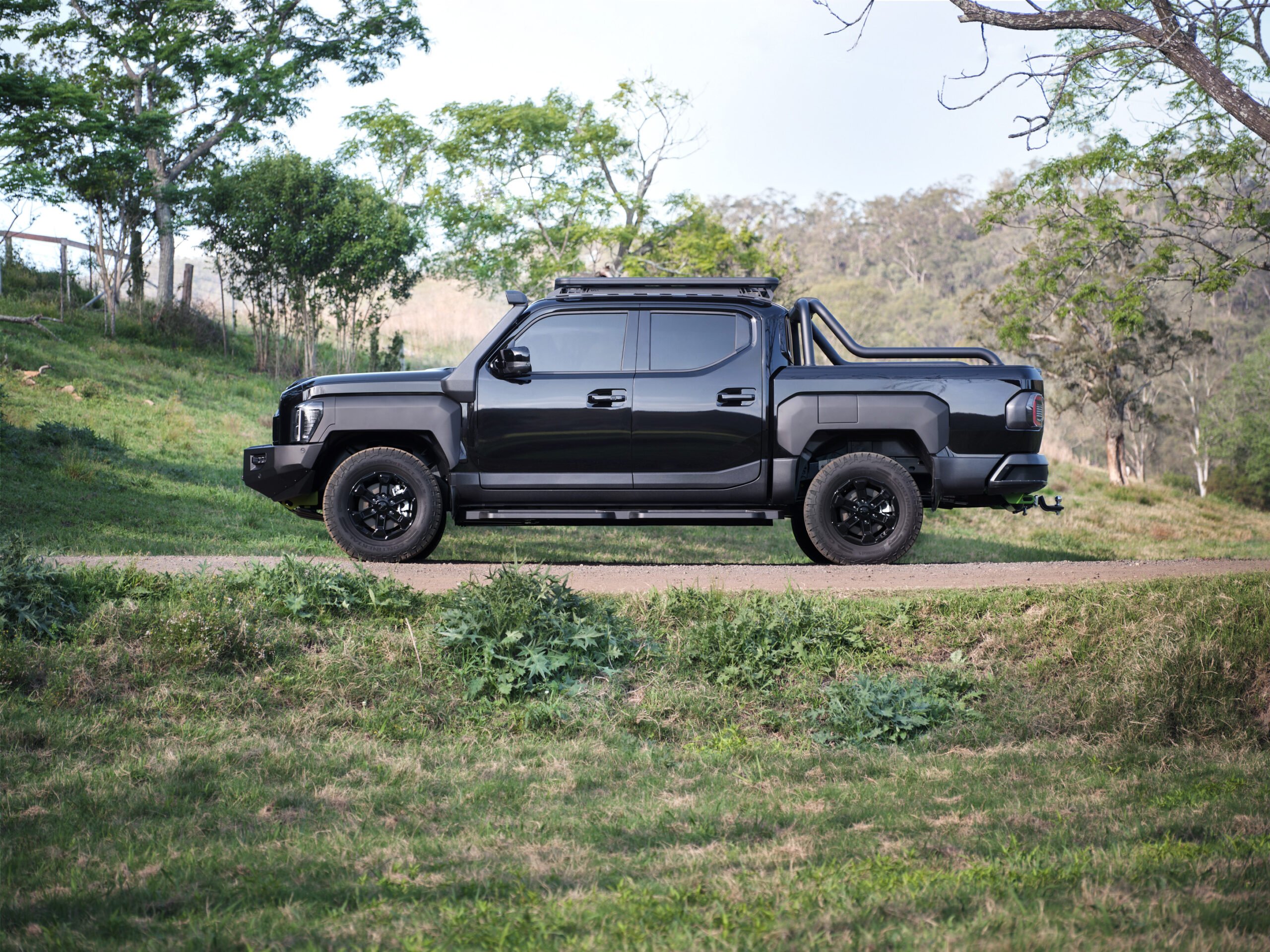- The long-awaited dual-cab ute from KIA makes its debut ahead of a mid-2025 arrival.
- The Tasman will be offered exclusively in a diesel internal combustion format for Australia.
- Pricing is TBC, but this article shares our first reactions from the launch here in Hobart, Tasmania.
KIA’s first-ever ute has made its global debut. It’s called The Tasman, and while the Korean automaker has set its sights on lofty global domination and wider market appeal, it’s hard to look past it as being inextricably linked to us dual-cab-loving drivers here Down Under.
Aside from the fact that KIA has just launched a ute (and it has Aussie naming rights), it’s worth noting that it’ll debut as an internal combustion engine vehicle, not an EV. You’d be forgiven for assuming it would be electric, given KIA has peddled the EV message hard with the EV5, EV6, and EV9 in recent years.
All three trims of the KIA Tasman — the Baseline, X-Line, and X-Pro — were revealed simultaneously in Jeddah, Seoul, and Hobart today. And if it’s a day you never saw coming, you’d be forgiven for thinking so.

So what’s the story behind the KIA Tasman?
The Tasman is KIA’s first (dual) cab off the rank for the brand’s upcoming pickup range, with an EV variant expected to follow. This is not a car that aligns with the Korean domestic market. Rather, the Tasman is taking the fight to the ever-popular (and very well-established) segment internationally as a competitive utility workhorse, with a few little luxuries we’ve come to expect from KIA in recent years.
Who is the buyer?
Just five years ago, KIA as an automaker wouldn’t have passed the ‘pub test’, let alone a KIA ute. Come 2025, it just might turn a few heads. The Tasman will likely be considered by those caught somewhere between the segment-dominating Ford Ranger (and Toyota Hilux, for that matter) and the tsunami of Chinese entry-level brands flooding the market. How many heads it does indeed turn, however, will depend on its price point, which is still undetermined.
Tell us about your first impressions.
In its tactical ‘tan beige’ global launch imagery and with a host of blacked-out features, the Tasman is tough. KIA has clearly taken note of the aesthetic hesitations that loomed over its initial design concept. Here in Hobart, the black spec we’re witnessing in the metal is hard to fault, especially with all its kit bolted on for full effect.

Throughout the 2020s, KIA has achieved mammoth leaps forward in the EV space, enjoying a blank canvas for its radical new design approach. Despite being introduced with an internal combustion drivetrain, at first glance, the Tasman continues the trend of bold, angular facades to project power and tactility. The pickup’s width is particularly pronounced by the hood trim, grille frame, and fender eyebrows — affectionately known together as the Kia ‘Tiger Face.’
What immediately stands out to us is the Tasman’s 1,173 litres of cargo capability. For once we’re inclined to drink the cool aid from the press release and agree the “class-leading space” does, in fact, look wildly impressive. KIA customers will be used to the space afforded to them in the EV range, and it’s clear the Korean marque is determined to continue this theme of practicality despite the Tasman’s ICE powertrain.

Give us the top line on performance and efficiency.
In the Australian market, the pickup will only be offered with a 2.2-litre diesel engine putting down 210PS (roughly 154kW) and capable of producing 441Nm of torque. We’re quietly excited about its eight-speed automatic gearbox, which, anecdotally on the ground here in Tasmania, is being touted as refreshingly responsive for the dual-cab segment and properly calibrated to match the car’s output, particularly off-road. A hypothesis we’ll put to the test next year.
Tech and connectivity — what’s the word?
In total, we’re talking a 12.3-inch + 5-inch + 12.3-inch panoramic widescreen display. An optional eight-speaker Harmon Kardon premium audio system allows users to take full advantage of the standard-fit Apple CarPlay and Android Auto integration. There are also nifty features such as an illuminated load bed, “ground view” cameras to assist with off-roading, and a sliding cargo floor to make it even more practical.

And what about the boring safety stuff?
ADAS, which has been a little too eager on some recent KIA models, is nonetheless stacked with all the lane-keeping and driver-assistance features you’d expect in 2025. Notably, version two of KIA’s Highway Driving Assist has been optimised with trailer profile functionality in mind. This function enables the specification of the trailer to be incorporated into the pickup’s ADAS, which then automatically optimises driving characteristics accordingly.
All-terrain confidence has been finetuned everywhere from the snowy tundras of Sweden to the scorching deserts in the Aussie outback.

The most memorable — or heartbreaking — thing about the Tasman?
Critics will point to the Tasman’s modest power output as one to watch. Especially with the biggest and gruntiest 4X4s from North America flanking Aussie drivers more and more by the day. Time will tell, but if the motor works in harmony with all of its parts as well as KIA expect it to, it shouldn’t be an issue.
One thing you should know before taking a test drive?
What I’ve come to learn from my time behind the wheel of the new stuff from KIA — is to not knock it until you try it. But I’ve yet to try it, so let’s revisit this again when it arrives in Australia in mid-2025.
Tell us the price, son!
Ha! Not yet. Though the Tasman will have to undercut the competition, that’s for sure. The Hilux and Ranger are the reigning segment royalty for a reason — at least with respect to sales — so we’re likely looking at the Mitsubishi Triton for some pricing perspective.

















